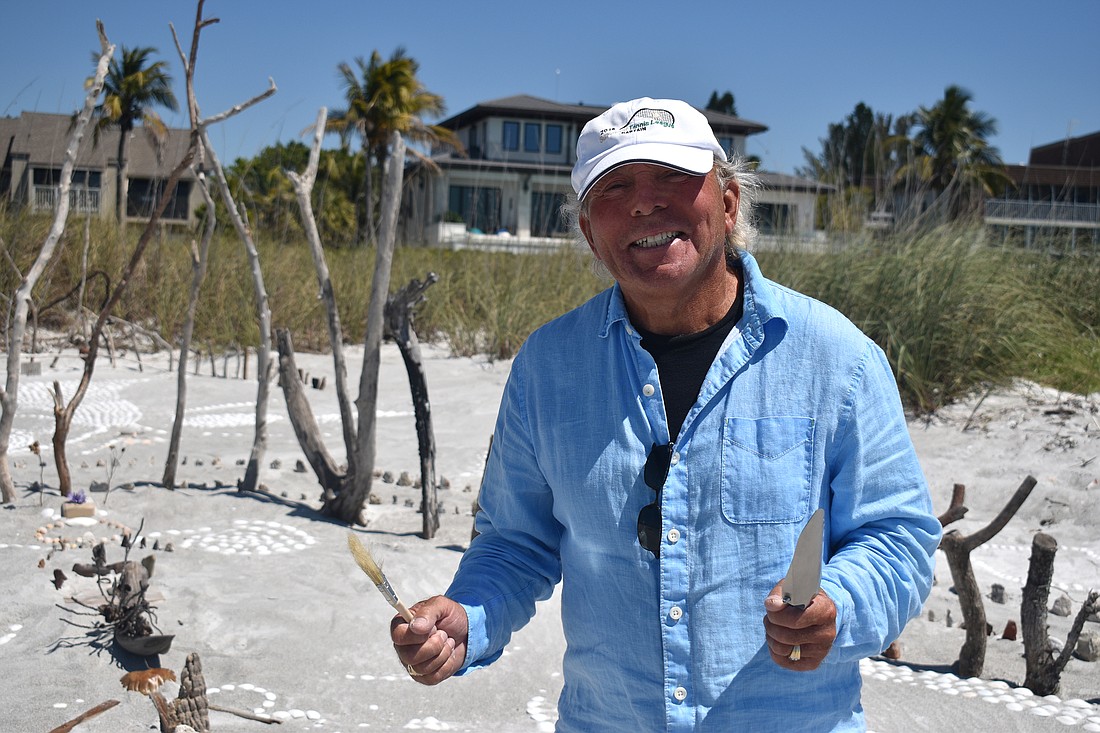- November 16, 2024
-
-
Loading

Loading

Walking on the beach lends itself to a treasure hunt.
Shells, sand dollars and even branches artfully litter the shoreline waiting to be admired.
But when venturing on the shore near Banyan Bay Club, beachgoers might find themselves in front of a large piece of artwork created by resident Robert Dreyfus.
Every year, Dreyfus gathers natural beach treasures (except for an artificial purple flower he found on the ground at Publix) into a symmetrical art creation.
The art outside of the Banyan Bay Club began in 2007 when he moved to Longboat Key. Previous works made on Nantucket, Mass., were oriented vertically.
This year’s is horizontal.
All it took was one three-prong piece of driftwood for Dreyfus’ idea to come to life. The pattern arcs from there with sticks and branches found mostly on the north end of Longboat Key near Greer Island, known colloquially as Beer Can Island. Weaving in front of the branches are various shells mostly formed into shapes resembling Fibonacci numbers.
Down the center is a line of items that are midsized. The purple flower sits top center, while pieces of coral and a small log topped with shells finishes the other end of the line.
“This year, I just went with a more open design,” Dreyfus said. “There have been tough times when I’ve had giant pieces that start out small then big, then I probably had a couple thousand shells that came down the beach. This time, I used a lot of positive space with the shells and negative space with the sand, which frames it and brings it out.”
Dreyfus’ venture in beach art began with collecting shells.
After storms, he would walk the beach and come back “with amazing shells.” He would clean them and send them to friends and family. Eventually, his shells piled up in the house, so he found a creative outlet.
Dreyfus estimates he collects shells 10 to 12 times a year. He said it took six to seven weeks of working, laying it all out and collecting in both the morning and afternoons to complete this year’s piece. He maintains it each day by brushing off sand-covered shells or removing seaweed. Dreyfus estimates there about a couple thousand shells in the piece.
He fills up a paint bucket with as many shells as he can carry, usually clam shells, because tourists don’t want those, he said. Most beachgoers, he has found, look for unusual ones such as venus sun ray shells or lettered olive shells.
Dreyfus plans to keep the installation up until turtle nesting season begins in May, unless nature has other plans.
“Every time I do a piece, people say to me, ‘Well, what if the tide comes up and washes it away?’,” Dreyfus said. “Well, I’m not a Buddhist, but what they say is everything is impermanent.”
Occasionally, Dreyfus is near the water when people stop to look at his work, which allows him to interact with them.
Dreyfus wants people to know the artwork can be whatever they want it to be. Some tell him they see a butterfly. Others see a bird. He agrees with them all.
He has seen beachgoers make their own art designs after looking at his piece, whether it was a group of Alaskans writing “Alaska” in the sand or a couple drawing a heart and putting their names in the middle.
Mostly though, Dreyfus just wants the creation to be a spot for a moment of peace.
This year’s design has a path lined with shells beachgoers can use to walk the arc of the installation, so the back of the design is noticed as well.
“It does inspire people, but mostly this is for people walking up, coming by and taking a look and taking a moment to just sort of zen out,” he said.